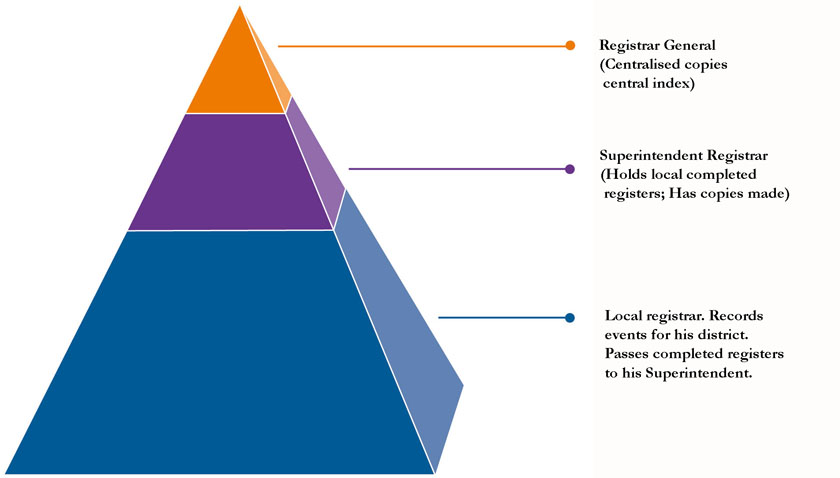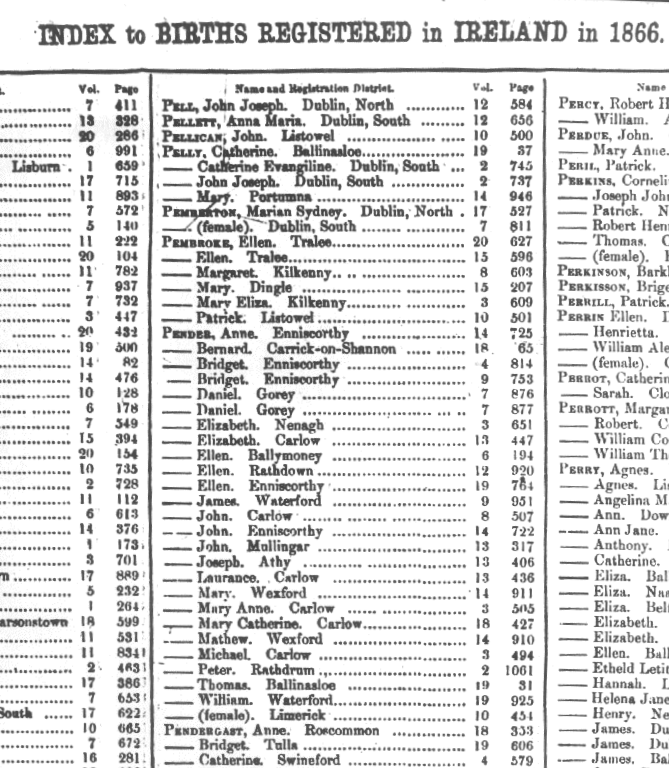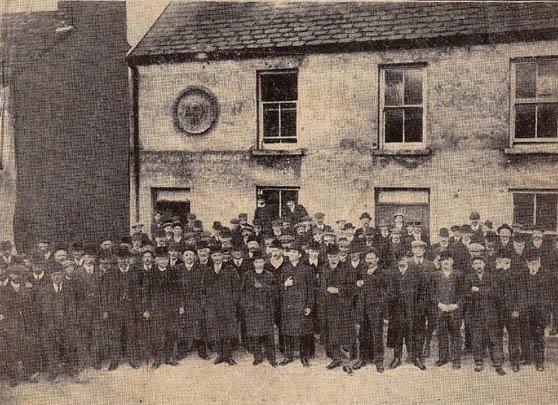Since last week’s additions to IrishGenealogy’s birth, marriage and death records, I’ve been wallowing around in the site, as happy as a pig in … a toy-shop. I’ve spent almost all my working life dealing with these records, or rather fishing for them through the tiny keyhole provided by the printed indexes. Suddenly we’ve been handed the key itself.
There should be conga-lines of genealogists dancing down O’Connell Street.
Some background: The General Register Office system for registering births, deaths and marriages in Ireland was (is) a perfect Victorian pyramid. The already-existing Poor Law Unions, catchment areas for a workhouse located in a large market town, were drafted in for double-duty to be used as the geographical basis of registration, and given the additional title “Superintendent Registrar’s District”. Most of them were already subdivided into local health areas, “Dispensary Districts”, which then also became “Registrar’s Districts”.

It was the job of the local registrar to record births and deaths (marriages were always a bit different) in pre-printed registers. Every three months these registers were passed to the Registrar’s boss, the Superintendent Registrar. He then had copies made of all the local registers and sent them to his superior, the top of the pyramid, the Registrar General.

The Registrar General then had these copies indexed, producing printed indexes, covering births, deaths and marriages for the entire island, one volume per year until 1877, four per year thereafter. These are the indexes available in the General Register Office Search room in Dublin, until now, in theory at least, the only legal route of access to the historic registrations: the keyhole.
FamilySearch made a digital transcript of these indexes freely available more than five years ago, right up to 1958. In 2015, IrishGenealogy put up the GRO’s internal digital index (slightly more informative), but restricted to more than 100 years old for births, 75 for marriages and 50 for deaths.

What’s happened now is that IrishGenealogy has added online digital images of the copy-registers that its indexes point to. If you think your ancestor was one of the 25 John Murphy births registered in Kanturk Union between 1873 and 1876, up to now the only way to check full details of the entries was to buy print-outs of the images, a cool €100 in the case of the bould John. Now you can simply (and for nothing) click through each index entry and see full details: address, father’s occupation, mother’s maiden name …
Of course there are quibbles. Only the birth record images are complete. The marriage images start in 1882 and the deaths in 1891, so it’s still necessary to buy print-outs for marriages and deaths before those years. O and Mc surnames are treated very strangely in the indexes after 1900. The way the image digitisation was done makes it unnecessarily difficult (but not impossible) to reconstruct the local registrars’ records, an obvious treasure-trove for local historians. And some of the early registrations don’t seem to be imaged – Mary Scully in Abbeyleix Union in 1864 seems to have fallen between stools, for example. The FamilySearch transcript has much more information – an object lesson in the value of multiple transcripts.
But these are just tiny examples of that familiar occupational hazard, NGS, Nitpicking Genealogist Syndrome. What our Department of Arts, Heritage, Regional, Rural and Gaeltacht Affairs has just done is simply extraordinary.
Ireland, a notorious black spot for family history less than a decade ago, is now a world leader in access to genealogical records.
Thanks for sharing the mechanics of how the layers of these records were assembled, John. I too have been really enjoying the access over the weekend. Not so much because of brick walls broken down – but because of the colour and texture added to what were previously just names and dates. Mike Collins.
Absolutely wonderful!!
You say it’s difficult but not impossible but how does one reconstruct the local registrars’ records?
i.e. how do I turn to the next page?
This is what you see when you’re looking at a register page-image: . That final number “2253803” is the one you need to change. Add 1 to move a page forward, subtract 1 to move a page back.
. That final number “2253803” is the one you need to change. Add 1 to move a page forward, subtract 1 to move a page back.
For the early years, the copies of local registrars’ registers seem to have been divided into quarters retrospectively, so you’ll only ever get three months at a run.
Thanks John, I had the added difficulty of an entry for Dublin South linking to an image for Dundalk but I got there in the end.
Thank you for the page turning tip. It’s nice to scroll through the pages just in case. I’ve broken a brick wall with the new records which led me to some current living cousins in Mayo. It’s been a good weekend of searching.
Thank you John! ?
This is an incredible gift, that I am very pleased to use. Thank you for your explanations.
John,
Lets not go as far as a world leader in relation to Irish genealogical records?? After all, if you are looking for a birth from 1916?the system is blank, and that goes for the NLI church records; 75 years for marriages, & 50 years for deaths. When the rest of the known worlds records up to 2010?? can be viewed on line??
So John, Ireland still has a long way to go before coming a world leader in Irish genealogical records.
“Rest of the known world’s records. . . ?” I live in the US. My state’s records are only available online up through 1920. I know other US state’s are even worse.
This move of putting the civil records online for Ireland, however incomplete, is still a step in the right direction.
Glory Hallelujah! Do we have any kind of estimate as to when, if ever, marriages and deaths will be complete?
Thank you John!
Small note to people who are tearing their hair out for missing relations. I found the death my 2nd great grandfather, Bartley (Bartholomew) Loughney, on rootsireland.ie – but when I tried to order the record from the GRO, they could not find it. I eventually contacted the local Mayo registry, and they found it. The GRO index is not complete.
That’s interesting, I’ve had no luck finding any record of my granny’s birth in the Kilmallock area around 1908, either via the GRO originally, or myself using the new data online.
Is there a Registrars office in Wicklow as I cannot find birth for my Great grandmother Elizabeth Morgan born c.1862 in Wicklow. I have her marriage in Dublin and death, but birth is a mystery. Thank you.
Wicklow is covered by the Unions of Rathdown, Rathdrum, Baltinglass and Shillelagh.
lol im trying to find my grt grt aunt Elizabeth morgan death cert
Hi Olive, the Registration office for Co. Wicklow is based at the Health Centre, Main St Bray. However, you should be aware that the civil records only began in 1864, also, at the beginning, a few areas bordering Kildare and Carlow were within the Wicklow Supt. Registrar’s area. Mary
1862 is too early for civil registration. It began in 1864.
John
Thank you this is wonderful but it looks like the local records as the source information for the rest of your pyramid are better records in that they are complete ( and perhaps they can be searched by Townland?).
As part of the rational for releasing these record online and free of charge is to encourage “ancestral” tourism, wouldn’t it make sense to release the local records online too, which would do more to encourage tourism to that specific locality or county?
As our Genealogy Ambassador your would be in a good position to promote this idea. Does that make sense?
Tom, the local records ie Registration books, Contain the records for all the townlands within the Registrar’s district – they’re not in any particular order. Often, the local Registrar travelled to different locations in his/her district on different days of the week to enable locals to register BDMs. In my experience with the records in Co. Wicklow, the registrars were often the local Dispensary Doctors.
John
A wonderful explanation of the new Irish BDM release.
I have spent the last four days finding as many Murray relatives of my husband from Dublin, Moy and Dungannon.
Diligence and persistence will reap wonderful rewards.
Now if only NSW Australia could follow Irelands lead 🙂
The records are fabulous — I’ve started with the deaths, to establish my estimated birth dates, and had great luck. For a US researcher with limited time/funds to order GRO certs — this is a Godsend! I have so many common names (Mary Walsh, Patrick Conneely, etc), that to be able to actually see the Townland name, and informant name – has enabled me to identify MANY ancestors!
BRAVO!
Thanks for promulgating this. It has been a treasure trove. Do you know if there are plans to add images for any more of the records that are still index-only?
Plans, yes. A firm timetable, no.
I didn’t realise the registers were transcripts – which means the local registrar could have made a slip, made doubly erroneous in transcription.
Mr. G:
Despite everything, I am totally excited with yet another release ..each one many not be perfect, and it may not include everything, but it still has a bunch more than we did before! Am so happy 🙂